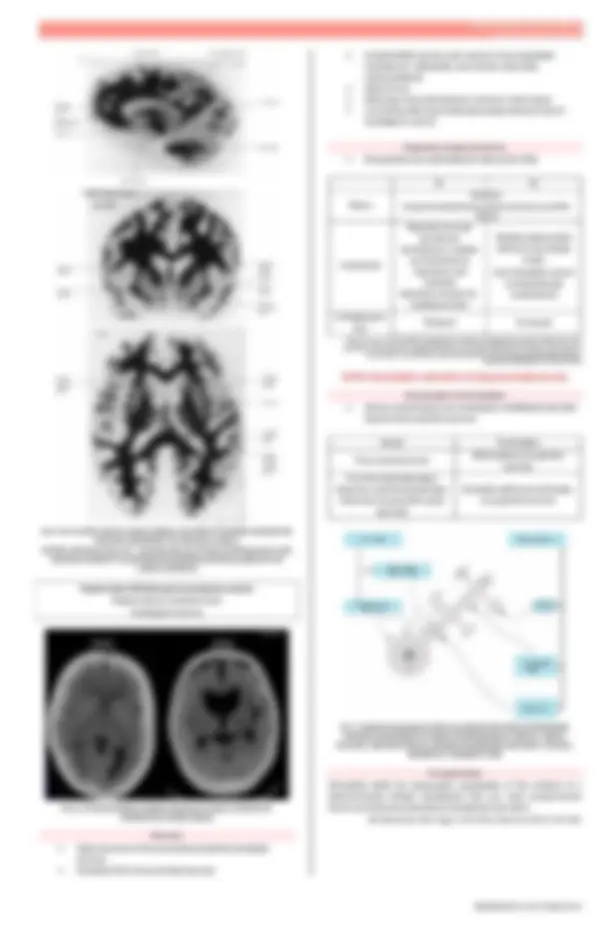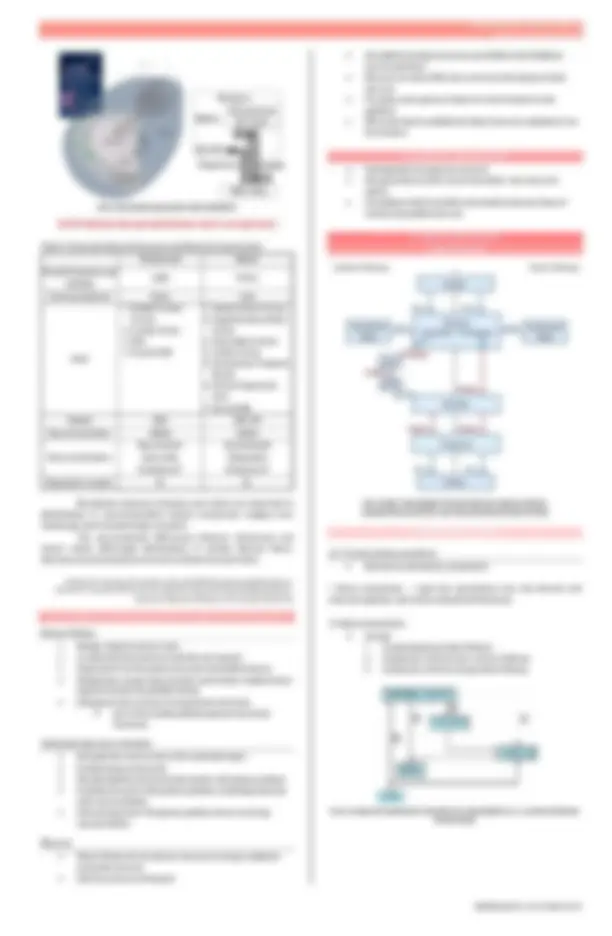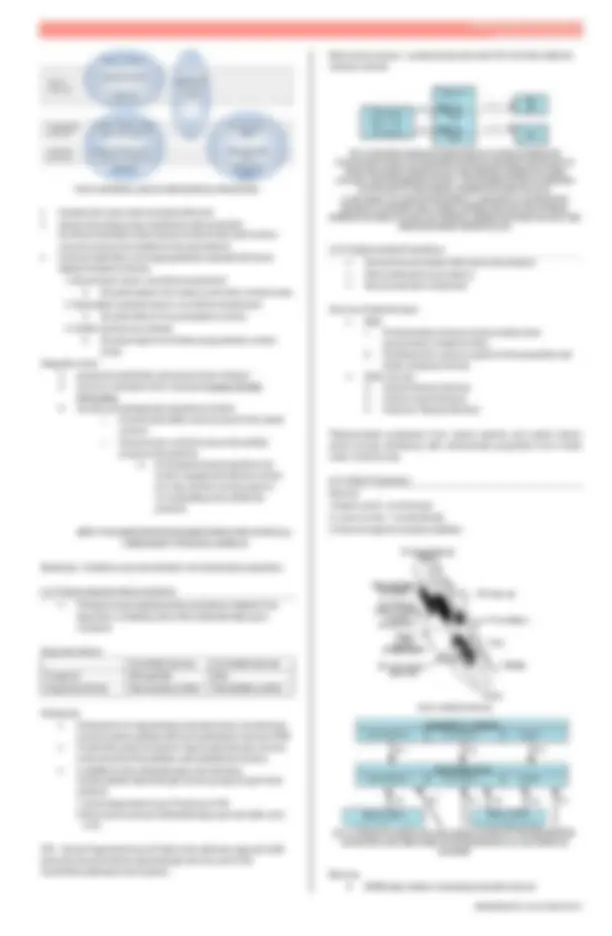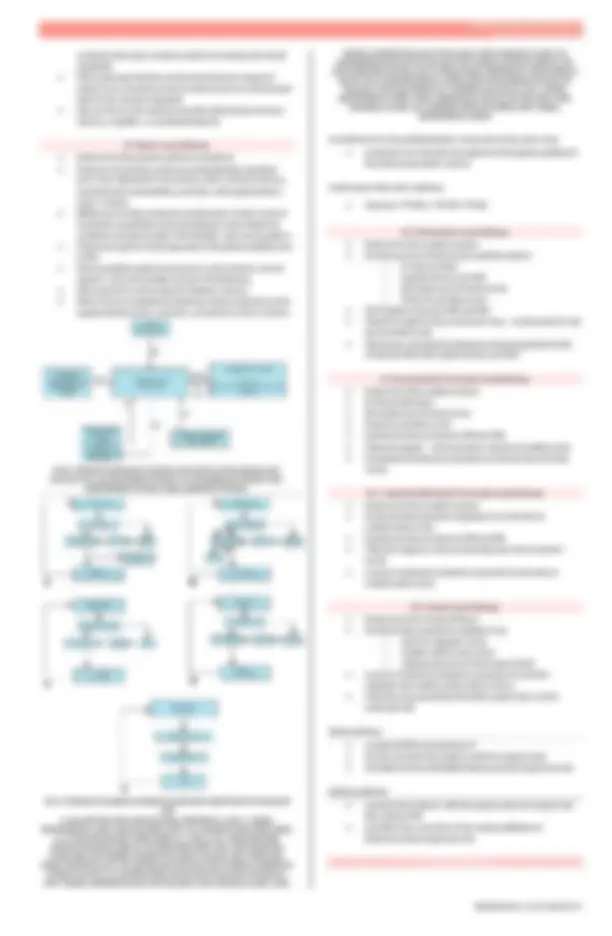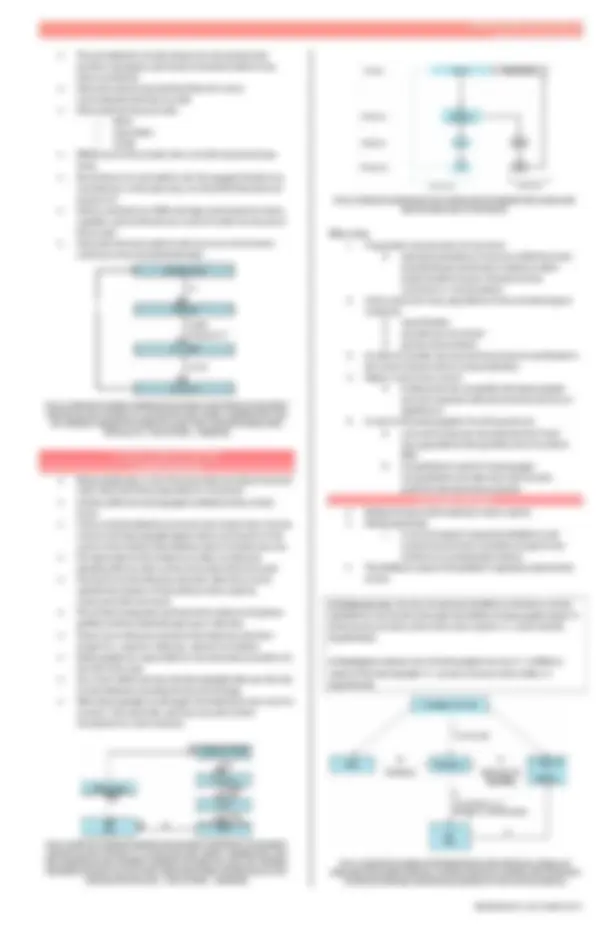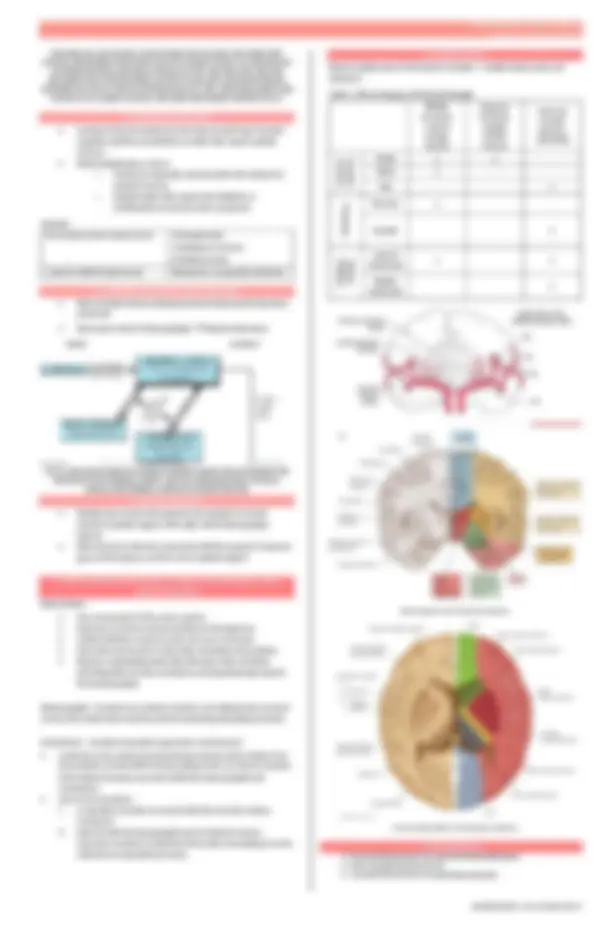Download Basal Ganglia Reviewer and more Study notes Neuroanatomy in PDF only on Docsity!
Book trans (Afifi & Bergman) OUTLINE I. INTRODUCTION A. DEFINITIONS AND NOMENCLATURE B. NEURONAL POPULATION, SYNAPTIC RELATIONS, AND INTERNAL ORGANIZATION II. INPUTS AND OUTPUTS A. NEOSTRIATUM B. PALLIDUM AND SUBSTANTIA NIGRA C. SUBTHALAMIC NUCLEUS D. VENTRAL (LIMBIC) STRIATUM E. CONTRICOSTRIATOTHALAMOCORTICAL LOOPS F. SPLIT PATHWAYS III. BASAL GANGLIA FUNCTIONS A. MOTOR FUNCTION B. GATING FUNCTION C. COGNITIVE FUNCTION D. EMOTION AND MOTIVATION FUNCTION E. SPATIAL NEGLECT IV. COMPLEMENTARITY OF BASAL GANGLIA AND CEREBELLUM IN MOTOR FUNCTION V. BLOOD SUPPLY VI. REFERENCES I. INTRODUCTION, DEFINITIONS AND NOMENCLATURE Neuronal control of movement – product of interactions within and among a number of cortical and subcortical neural structures Important subcortical structures: ➢ Basal ganglia ➢ Cerebellum ➢ Dopaminergic mesencephalic (midbrain) system FIG 1.1. CORONAL SECTIONS SHOWING THE BASAL GANGLIA COMPONENTS Table 1. Basal Ganglia Nomenclature Corpus striatum Striatum/ dorsal striatum/ neostriatum Ventral striatum Pallidum/ paleostriatum Lentiform nucleus Caudate + + + (ventral parts)
Putamen + + (^) (ventral parts)+ – + Globus pallidus
Nucleus accumbens
Olfactory tubercle
Nucleus Accumbens (Septi) – NAcc; “nucleus adjacent to the septum” Globus pallidus – “pale ball” Putamen – “shell” Caudate – “tail” FIG 2. SIMPLIFIED SCHEMATIC DIAGRAM OF MAJOR CORTICAL AND SUBCORTICAL NEURAL STRUCTURES INVOLVED IN MOVEMENT: 1, CORTICOSPINAL TRACT; 2, CEREBROCEREBELLAR PATHWAYS; 3, CORTICOSTRIATE PATHWAYS; 4, DENTATOTHALAMIC PATHWAYS; 5, STRIATOTHALAMIC PATHWAYS; 6, THALAMOCORTICAL PATHWAYS; AND 7, DOPAMINERGIC PATHWAYS Lesions in the basal ganglia or cerebellum Result in uncoordinated and disorganized movement (ie Parkinsonism, Huntington’s chorea) A. DEFINITIONS AND NOMENCLATURE Basal ganglia
- Group of interconnected nuclei involved in motor and nonmotor functions ANATOMICALLY, it refers to the ff nuclei located @base of brain FUNCTIONALLY, it includes Caudate Putamen Olfactory Tubercle Nucleus Accumbens Septi Globus Pallidus Substantia nigra Subthalamic nucleus FIG. 1.2. BASAL GANGLIA RELATED STRUCTURES
Book trans (Afifi & Bergman) FIG 3. BASAL GANGLIA AND RELATED STRUCTURES Extrapyramidal system
- Basal ganglia and an array of brain stem nuclei: ➢ Red nucleus ➢ Subthalamic nucleus ➢ Substantia nigra ➢ Reticular formation
- Plays an important role in motor control FIG 4. EXTRAPYRAMIDAL SYSTEM (TOP: TRACTS; MIDDLE: CORONAL SECTION SHOWING NUCLEI; BOTTOM: RETICULAR FORMATION) B. NEURONAL POPULATION, SYNAPTIC RELATIONS, AND INTERNAL ORGANIZATION B.1. NEOSTRIATUM
- Both nuclei (caudate nucleus + putamen) are of telencephalic origin ➢ During ontogenesis, the caudate nucleus follows the curvature of the telencephalic vesicle ➢ C-shaped structure with expanded rostral extremity ➢ Head tapers down to form a body and tail (see FIG 3) Head Bulges into the lateral ventricle, characteristic relationship to the lateral wall of the anterior horn and body of the lateral ventricles Body Relationship to the lateral wall of the anterior horn and body of the lateral ventricles Tail Roof of the inferior horn of the lateral ventricle Very small in humans
Book trans (Afifi & Bergman) FIG 8. STRIOSOME AND MATRIX COMPARTMENTS
NOTE: Patches interspersed between matrix compartment
Table 2. Characteristics of Striosome and Matrix Compartments Striosomes Matrix Acetylcholinesterase staining Light Heavy Cell development Early Late Input
- Medial Frontal Cortex
- Limbic Cortex
- SNc
- Ventral SNr
- Sensorimotor Cortex
- Supplementary Motor Cortex
- Association Cortex
- Limbic Cortex
- Intralaminar Thalamic Nuclei
- Ventral Tegmental Area
- Dorsal SNc Output SNc SNr, GP Neurotransmitter GABA GABA Neuromodulators Neurotensin Dynorphin Substance P Somatostatin Enkephalin Substance P Dopamine receptor D 1 D 2 Boundaries between striosome and matrix are important in distributions of neurotransmitter-related compounds ranging from cholinergic and monoaminergic receptors. The neurochemical differences between striosomes and matrix reflect differential distributions of striatal afferent fibers, interneurons and projection neurons in striosomes and matrix. Graybiel A.M., Flaherty A.W., Giménez-Amaya JM. (1991) Striosomes and Matrisomes. In: Bernardi G., Carpenter M.B., Di Chiara G., Morelli M., Stanzione P. (eds) The Basal Ganglia III. Advances in Behavioral Biology, vol 39. Springer, Boston, MA B.2. GLOBUS PALLIDUS AND SUBSTANTIA NIGRA PARS RETICULATA Globus Pallidus
- Wedge-shaped nuclear mass
- Located between putamen and internal capsule
- Separated from the putamen by external pallidal lamina
- Divided into a larger lateral (outer) and smaller medial (inner) segment by internal pallidal lamina
- Entopeduncular nucleus of nonprimate mammals ➢ part of the medial pallidal segment in primate mammals Substantia nigra pars reticulata
- Occupies the ventral zone of the substantia nigra
- Contains iron compounds
- Morphologically and chemically similar with globus pallidus
- Considered a part of the globus pallidus containing head and neck representation
- Internal segment of the globus pallidus has arm and leg representation Neurons
- Most of these two structures’ neurons are large multipolar projection neurons
- Interneurons are infrequent
- All pallidal and nigral neurons use GABA as the inhibitory neurotransmitter
- Neurons are about 100x less numerous than spiny striatal neurons
- Provides convergence of input from the striatum to the pallidum
- 90% of the input to pallidal and nigral neurons originates from the striatum B.3. SUBTHALAMIC NUCLEUS
- Cytologically homogenous neurons
- Use glutamate as their neurotransmitter, has only a few spines
- Immediate in their dendritic arborization between those of striatal and pallidal neurons III. INPUTS AND OUTPUTS A. NEOSTRIATUM FIG 9. DIRECT AND INDIRECT PROJECTIONS OF CORTICOSTRIATE, MESENCEPHALOSTRIATE, AND THALAMOSTRIATE PROJECTIONS A.1. NEOSTRIATAL INPUTS A.1.1. Corticostriate projections
- Both direct and indirect projections
- Direct projections – reach the neostriatum thru the internal and external capsules, and via the subcallosal fasciculus
- Indirect projections ➢ Include:
- Corticothalamostriate Pathway
- Collaterals of the Cortico-olivary Pathway
- Collaterals of the Corticopontine Pathway FIG 12. SCHEMATIC DIAGRAM OF THE DIRECT (1) AND INDIRECT (2, 3, 4) CORTICOSTRIATE PROJECTIONS
Book trans (Afifi & Bergman) FIG 1 0. FUNCTIONAL LOGIC OF CORTICOSTRIATAL PROJECTIONS
- Contains the most massive striatal afferents
- Almost all cortical areas contribute to this projection (corticocortical fibers that connect cortical areas tend to share common zones of termination in the neostriatum)
- Corticostriatal fibers are topographically organized into three distinct striatal territories: 1. Sensorimotor (post-commissural putamen) ➢ Receives inputs from sensory and motor cortical areas 2. Associative (caudate and pre-commissured putamen) ➢ Receives fibers from association cortices 3. Limbic (nucleus accumbens) ➢ Receives input from limbic and paralimbic cortical areas Cingulate cortex ➢ projects to both limbic and sensorimotor striatum ➢ serves to modulate motor responses based on limbic information ➢ are also somatotopically organized such that: o Cortical association areas project to the caudal nucleus o Sensorimotor cortical areas preferentially project to the putamen → Corticoputamenal projections are further organized in that the cortical arm, leg, and face areas project to corresponding areas within the putamen NOTE: THIS SOMATOTOPIC ORGANIZATION IS REFLECTED ALL THROUGHOUT THE BASAL GANGLIA Glutamate - Excitatory neurotransmitter of corticostriate projections A.1.2. Mesencephalostriate projections
- Principal mesencephalostriate projections originate from dopamine-containing cells of the substantia nigra pars compacta Dopamine effects D 1 striatal neurons D 2 striatal neurons Project to GPi and SNr GPe Dopamine effects Net excitatory effect Net inhibitory effect Collaterals
- Collaterals from nigrostriate projections have recently been traced to globus pallidus (GP) and subthalamic nucleus (STN)
- Provide the anatomic basis for nigral dopaminergic neurons to directly affect the pallidum and subthalamic nucleus
- In addition to the substantia nigra, the following mesencephalic dopaminergic nuclear groups project to the striatum:
- Ventral tegmental area of Tsai (area A-10)
- Retrorubral nucleus (Substantia nigra pars dorsalis, area A-8) VTA – Ventral Tegmental Area (of Tsai); in the midbrain, adjacent to SN; primarily characterized by dopaminergic neurons; part of the mesolimbic pathway/reward system Retrorubral nucleus – caudal and dorsal to the VTA; 1/3 of the midbrain reticular nucleus FIG 11. SCHEMATIC DIAGRAM OF NIGROSTRIATAL PATHWAY SHOWING THE FACILITATORY ACTION (+) OF DOPAMINE ON STRIATAL NEURONS THAT PROJECT TO SUBSTANTIA NIGRA PARS RETICULATA AND INTERNAL SEGMENT OF GLOBUS PALLIDUS, AND THE INHIBITORY ACTION (–) OF DOPAMINE ON STRIATAL NEURONS THAT PROJECT TO THE EXTERNAL SEGMENT OF GLOBUS PALLIDUS. D 1 , DOPAMINE 1 CLASS RECEPTOR NEURON; D 2 , DOPAMINE 2 CLASS RECEPTOR NEURON; DA, DOPAMINE; GABA, GAMMA-AMINOBUTYRIC ACID; GPE, EXTERNAL SEGMENT OF GLOBUS PALLIDUS; GPI, INTERNAL SEGMENT OF GLOBUS PALLIDUS; SNR, SUBSTANTIA NIGRA PARS RETICULATA. A.1.3. Thalamostriate Projections
- Second most prominent afferents to the striatum
- Fibers believed to be excitatory
- Neurotransmitter: Glutamate Sources of thalamic input
- Main:
- Corticomedian nucleus projects mainly to the sensorimotor striatal territory
- Parafascicular nucleus projects to the associative and limbic striatal territories
- Other sources: ➢ Ventral Anterior Nucleus ➢ Ventral Lateral Nucleus ➢ Posterior Thalamic Nucleus Thalamostriate projections from ventral anterior and ventral lateral nuclei overlap extensively with corticostriate projections from frontal motor cortical areas A.1.4. Other Projections Sources:
- Raphe nuclei – serotonergic
- Locus cerulus – noradrenergic
- External segment of globus pallidus FIG 12. VARIOUS NUCLEI FIG 13. SCHEMATIC DIAGRAM OF MAJOR SOURCES OF INPUT TO THE SENSORIMOTOR, ASSOCIATION, AND LIMBIC ZONES OF THE NEOSTRIATUM. GLU, GLUTAMINE; DA, DOPAMINE. Neurons ➢ GABAergic medium-size spiny projection neuron
Book trans (Afifi & Bergman) tract) to the brain stem nuclei related to head and eye movements C. Side Track Output
- Relates GPe with STN
- Neurotransmitter: GABA Basal ganglia and its related neural systems may be viewed as composed of:
- A core
- composed of the striatum and its pallidal and nigral targets 2 ) Regulators of the core
- fall into two categories: A) Regulators of The Striatum B) Pallidonigral Regulators C) SUBTHALAMIC NUCLEUS
- Divided into sensorimotor, associative, and limbic territories
- Receives inputs from the following: C.1 Corticosubthalamic projection
- Although the striatum is the main site of cortical input, the subthalamic nucleus receives excitatory glutamatergic projections primarily from the primary motor area, with minor contributions from prefrontal, premotor, and supplementary motor cortices
- Somatotopically and topographically organized, similar to the corticostriate projections. C.2. Pallidosubthalamic Projection
- A massive GABAergic projection from the external segment of globus pallidus to the subthalamic nucleus
- Plays an important role in the indirect pathway that links input and output nuclei of the basal ganglia C.3. Thalamosubthalamic Projection
- Centromedian and parafascicular nuclei comprise the major sources of this projection. C.4. Nigrosubthalamic Projection
- Dopaminergic pathway
- Originates from the SNc and the ventral tegmental area as collateral branches from the nigrostriatal pathway C.5. Reticulosubthalamic Projection
- The dorsal nucleus of the raphe is the main source of this serotonergic projection Clinical applications Major outflow from STN is to both segments of GP and to SNr Violent hyperkinesia of ballism Subthalamic nucleus lesions/lesions interrupting the subthalamic- pallidal connection Deep brain stimulation STN is a favorable site for deep brain stimulation Treatment of Parkinson’s dse Differences between striatal and subthalamic nucleus pathways Striatal pathway STN pathway ♥ Striatum receives from virtually all cortical areas ♥ Cortical input to STN is from frontal lobe ♥ Output from striatum is GABAergic (inhibitory and slow) ♥ Subthalamic nucleus output is glutamatergic (excitatory and fast) ♥ Provides focused inhibition of the output nuclei ♥ Pathways provide a fast, divergent excitation Both pathways provide the anatomic basis for the model of focused inhibition and surround excitation of output nuclei D. VENTRAL (LIMBIC) STRIATUM
- Ventral striatum refers to the following nuclei: o Nucleus accumbens septi o Striate-like deep portions of the olfactory tubercle o Ventral parts of the caudate nucleus o Putamen
- Receives fibers from the following sources: o Hippocampus o Amygdala o Entorhinal and perirhinal cortices (areas 28, 25) o Anterior cingulate cortex (area 24) o Medial orbitofrontal cortex o Widespread sources within the temporal lobe
- Substantial dopaminergic input
- Output is to the ventral palladium
- Related to the limbic system
- Plays a prominent role in reward and motivation, potential involvement in drug addiction and mental disorders such as schizophrenia and Tourette’s syndrome FIG 16. SIMPLIFIED SCHEMATIC SUMMARY DIAGRAM OF AFFERENT AND EFFERENT CONNECTIONS OF THE BASAL GANGLIA SHOWING THAT THE STRIATUM IS THE MAJOR RECEIVING AREA, WHEREAS THE INTERNAL SEGMENT OF GLOBUS PALLIDUS AND SUBSTANTIA NIGRA PARS RETICULATA CONSTITUTE THE MAJOR OUTPUT NUCLEI. +, FACILITATION; - , INHIBITION; DA, DOPAMINE; SER, SEROTONIN; NA, NORADRENALINE; GPE, EXTERNAL SEGMENT OF GLOBUS PALLIDUS; GPI, INTERNAL SEGMENT OF GLOBUS PALLIDUS; SNR, SUBSTANTIA NIGRA PARS RETICULATA; VA, VENTRAL ANTERIOR NUCLEUS; VL, VENTROLATERAL NUCLEUS; CM, CENTROMEDIAN NUCLEUS; DM, DORSOMEDIAL NUCLEUS. FIG 1 7. SCHEMATIC DIAGRAM SHOWING THE ORGANIZATION OF THE BASAL GANGLIA– ASSOCIATED NEURAL SYSTEM INTO A CORE MADE UP OF THE STRIATUM AND ITS PALLIDONIGRAL TARGETS, AND REGULATORS ACTING EITHER ON THE STRIATUM OR PALLIDONIGRAL COMPONENTS OF THE CORE. E. CORTICOSTRIATOTHALAMOCORTICAL LOOPS
- Organized in five parallel and largely segregated loops (circuits): o Motor o Oculomotor o Dorsolateral prefrontal o Lateral prefrontal o Limbic
- Information flow in each circuit passes from its cortical area of origin to the striatum (caudate, putamen, or ventral striatum), pallidum (dorsal or ventral), and thalamus before
Book trans (Afifi & Bergman) running to the major cortical area(s) from which each circuit originated
- This model says that the cortical areas that are targets of output from a channel are the cortical areas from which major input to the channel originated
- Injury to the circuit results in selective disturbance in motor, sensory, cognitive. or emotional behavior E.1. Motor Loop Pathway
- Centered on the putamen and its connections
- Putamen of primates receives somatotopically organized (arm, face, leg) inputs from primary motor, primary sensory, somatosensory association, premotor, and supplementary motor cortices
- Within each of these anatomic subchannels, further levels of functional organization exist pertaining to such behavioral variables as target location, limb kinetics, and muscle pattern
- Putamen projects to both segments of the globus pallidus and to SNr
- Internal pallidal segment projects to ventral lateral, ventral anterior, and centromedian nuclei of the thalamus
- SNr projects to ventral anterior thalamic nucleus
- Motor loop is completed by thalamocortical projections to the supplementary motor, premotor, and primary motor cortices FIG 1 8. SCHEMATIC DIAGRAM OF THE INPUT AND OUTPUT OF THE SUBTHALAMIC NUCLEUS. GLU, GLUTAMATERGIC PATHWAY; DA, DOPAMINERGIC PATHWAY; SER, SEROTONERGIC PATHWAY; GABA, GABAERGIC PATHWAY. FIG 1 9. SCHEMATIC DIAGRAMS SHOWING THE ANATOMIC SUBSTRATES OF THE MOTOR LOOP A, OCULOMOTOR LOOP B, DORSOLATERAL PREFRONTAL LOOP C, LATERAL ORBITOFRONTAL LOOP D, AND THE LIMBIC LOOP E. MC, PRIMARY MOTOR CORTEX (AREA 4); SC, PRIMARY SENSORY CORTEX (AREAS 3, 1, AND 2); SSA, SOMATOSENSORY ASSOCIATION CORTEX (AREA 5); PM, PREMOTOR CORTEX; SMA, SUPPLEMENTARY MOTOR AREA; GPI, INTERNAL SEGMENT OF GLOBUS PALLIDUS; SNR, SUBSTANTIA NIGRA PARS RETICULATA; STH, SUBTHALAMIC NUCLEUS; GPE, EXTERNAL SEGMENT OF GLOBUS PALLIDUS; VLO, VENTROLATERAL NUCLEUS OF THALAMUS, PARS ORALIS; VAPC, VENTRAL ANTERIOR NUCLEUS OF THALAMUS, PARS PARVICELLULARIS; VAMC, VENTRAL ANTERIOR NUCLEUS OF THALAMUS, PARS MAGNOCELLULARIS; CM, CENTROMEDIAN NUCLEUS OF THALAMUS; FEF, FRONTAL EYE FIELD (AREA 8); SEF, SUPPLEMENTARY EYE FIELD; DLPC, DORSOLATERAL PREFRONTAL CORTEX (AREAS 9 AND 10); PPC, POSTERIOR PARIETAL CORTEX; DMPM, DORSOMEDIAL NUCLEUS OF THALAMUS, PARS MULTIFORMIS; SC, SUPERIOR COLLICULUS; LOFC, LATERAL ORBITOFRONTAL CORTEX; DMMC, DORSOMEDIAL NUCLEUS OF THALAMUS, PARS MAGNOCELLULARIS; ACC, ANTERIOR CINGULATE CORTEX; MOFC, MEDIAL ORBITOFRONTAL CORTEX An offshoot from the pallidothalamic component of the motor loop
- projection from the internal segment of the globus pallidus to the pedunculopontine nucleus A side loop in this motor pathway
• Putamen → GPe → STN → GPi
E.2. Oculomotor Loop Pathway
- Centered on the caudate nucleus
- Cortical sources of input to the caudate nucleus: o Frontal eye field o Supplementary eye field o Dorsolateral prefrontal cortex o Posterior parietal cortex
- The Caudate projects to GPi and SNr
- Thalamic targets of the oculomotor loop – ventral anterior and dorsomedial nuclei
- This loop is completed by thalamocortical projections to the frontal eye field and supplementary eye field E.3. Dorsolateral Prefrontal Loop Pathway
- Centered on the caudate nucleus
- Corticostriate input:
- Dorsolateral prefrontal cortex
- Posterior parietal cortex
- Caudate nucleus projects to GPi and SNr
- Thalamic targets – ventral anterior and dorsomedial nuclei
- Completed by thalamic projections to the dorsal prefrontal cortex E.4. Lateral Orbitofrontal Prefrontal Loop Pathway
- Centered on the caudate nucleus
- Corticostriate projection originates from the lateral orbitofrontal cortex
- Caudate nucleus projects to GPi and SNr
- Thalamic targets are the dorsimedial and ventral anterior nuclei
- Loop is completed by thalamic projections to the lateral orbitofrontal cortex E.5. Limbic Loop Pathway
- Centered on the ventral striatum
- Corticostriate projections originate from o anterior cingulate cortex o medial orbitofrontal cortex o widespread areas in the temporal lobe
- Loop is completed by thalamic projections to anterior cingulate and medial orbitofrontal cortices
- It has been proposed that the limbic system has a role in schizophrenia Direct pathway
- contains GABA and substance P
- directly connects the striatum with the output nuclei
- activation tends to disinhibit thalamocortical target neurons Indirect pathway
- connects the striatum with the output nuclei via relays in the GPe and the STN
- activation has a net effect of increasing inhibition of thalamocortical target neurons F. SPLIT PATHWAYS
Book trans (Afifi & Bergman) COMMAND WILL BE FOCUSED. (3) INPUT FROM THE THALAMUS AND OTHER SITES UPDATES AND INFORMS STRIATUM OF ACTIVITY IN OTHER SYSTEMS. (4) STRIATUM HAS AN INTEGRATOR ROLE AND FEEDS ITS RESULTS TO GP AND SNR. (5) GP AND SNR INFLUENCE (FACILITATE OR INHIBIT) ACTIVITY OF THALAMUS AND OTHER TARGETS (SUPERIOR COLLICULUS, RETICULAR FORMATION, ETC). SNC, SUBSTANTIA NIGRA PARS COMPACTA; GP, GLOBUS PALLIDUS; SNR SUBSTANTIA NIGRA PARS RETICULATA. C. COGNITIVE FUNCTION
- Lesions of the dorsolateral prefrontal circuit (loop) result in cognitive deficits and deficits on tasks that require spatial memory
- Basal ganglia play a role in o retrieval of episodic and semantic information for explicit memory o implicit tasks that require the initiation or modification of central motor programs Lesions Dorsolateral prefrontal circuit Schizophrenia Huntington’s chorea Parkinson’s dse Lateral orbitofrontal circuit Obsessive-compulsive behavior D. EMOTION AND MOTIVATION FUNCTION
- Role of limbic lobe in schizophrenia and depression has been proposed
• Decrease in size of basal ganglia → bipolar disorders
FIG 24. SIMPLIFIED SCHEMATIC DIAGRAM SHOWING VARIED TYPES OF INFORMATION RECEIVED BY THE CEREBRAL CORTEX, AND THE COMPLEMENTARITY OF BASAL GANGLIA AND CEREBELLAR ROLES IN MOTOR FUNCTION E. SPATIAL NEGLECT
- Studies have shown the putamen (& caudate to a lesser extent) in spatial neglect with right-sided basal ganglia lesions
- Both nuclei are directly connected with the superior temporal gyrus which plays a central role in spatial neglect V. COMPLEMENTARITY OF BASAL GANGLIA AND CEREBELLUM IN MOTOR FUNCTION Both of them:
- Are components of the motor system
- Influence cerebral cortical activity via the thalamus
- Linked with the cerebral cortex via recurrent loops
- Have internal (local) circuitry that modulates loop activity
- Receive modulating inputs that influence their activities (climbing fibers in the cerebellum and dopaminergic input in the basal ganglia) Basal ganglia – functions as context encoders, providing to the cerebral cortex information that could be useful in planning and gating of action Cerebellum – functions as pattern generator and executor
- cerebral cortex, which receives diverse sensory information from the periphery via the different ascending tracts, as well as complex information already processed within the basal ganglia and cerebellum
- serves two functions:
- a repository function to receive this diverse information, compute it
- share it with the basal ganglia and cerebellum and an executive function to implement the action emanating from its collective computation process
VI. BLOOD SUPPLY
Rostromedial parts of the head of caudate – medial striate artery (of Huebner) Table 4. Blood Supply of the Basal Ganglia Middle cerebral, Lateral striate branch Anterior cerebral, medial striate branch Internal carotid, anterior choroidal nucleus Caudate Head x x Body x Tail x Putamen Rostral x Caudal x Pallidus Globus Lateral (external) x^ x Medial (internal) x FIG 25. BLOOD SUPPLY TO THE BASAL GANGLIA X. REFERENCES → Functional Neuroanatomy by Adel Afifi and Ronald Bergman → Other reputable internet sources → Journals cited with their corresponding paragraphs
Book trans (Afifi & Bergman) XI. APPENDIX FIG 25. BASAL GANGLIA NEUROCIRCUITS. BASAL GANGLIA NEUROCIRCUITS CAN BE BROADLY DIVIDED INTO THREE FUNCTIONAL LOOPS: THE SENSORIMOTOR, ASSOCIATIVE/COGNITIVE, AND LIMBIC NEUROCIRCUITS. DLS, DORSOLATERAL STRIATUM; DMS, DORSOMEDIAL STRIATUM; GPI, GLOBUS PALLIDUS INTERNAL SECTION; MD, MEDIAL DORSAL THALAMUS; NAC, NUCLEUS ACCUMBENS; SNC, SUBSTANTIA NIGRA PARS COMPACTA; SNR, SUBSTANTIA NIGRA PARS RETICULATA; VA, VENTRAL ANTERIOR THALAMUS; VL, VENTROLATERAL THALAMUS; VP, VENTRAL VALIDUM; VTA, VENTRAL TEGMENTAL AREA FIGURE 25. SUMMARY OF THE ORGANIZATION OF THE SUBSTANTIA NIGRA PARS RETICULATA AND PEDUNCULOPONTINE NUCLEUS IN LAMPREY. A: SCHEMATIC SHOWING THE EVOLUTIONARILY CONSERVED ARCHITECTURE OF THE BASAL GANGLIA. BLUE, RED, GREEN, AND PINK ARROWS INDICATE GABAERGIC, GLUTAMATERGIC, CHOLINERGIC, AND DOPAMINERGIC PROJECTIONS, RESPECTIVELY. B: SCHEMATIC SAGITTAL SECTION THROUGH THE LAMPREY BRAIN SHOWING THE LOCATION OF THE KNOWN BASAL GANGLIA NUCLEI AND THE CONNECTIVITY OF THE SNR.

